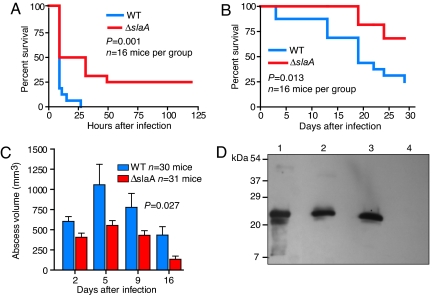Fig. 4.
SlaA contributes to GAS virulence in both septicemia and skin-lesion mouse models of infection. CD-1 Swiss male mice were inoculated i.p. with 2.5 × 107 cfu of wild-type MGAS315 or the ΔslaA isogenic mutant strain. Immunocompetent hairless mice (strain Clr:SKH1-hrBR) were s.c.-inoculated with 1 × 107 cfu. Kaplan–Meier survival curves were plotted to compare the difference in near mortality after i.p. (A) and s.c. (B) inoculation. (C) ΔslaA mutant strain induced significantly smaller lesions in the s.c. model of infection. Average lesion volumes were compared for the wild-type and ΔslaA mutant strains at various days postinfection. (D) Western immunoblot analysis showing production of SlaA at the lesion site. Mice were inoculated with wild-type or ΔslaA mutant strains, killed at 48 h postinfection, and tissue at the lesion site was excised. Proteins were extracted from the tissue and analyzed by Western immunoblot by using SlaA-specific polyclonal rabbit antibody. Lane 1, purified recombinant SlaA; lane 2, extract from wild-type-infected mice; lane 3, extract from ΔslaA-infected mice to which purified recombinant SlaA was added before extraction (extraction control); lane 4, extract from ΔslaA-infected mice.

